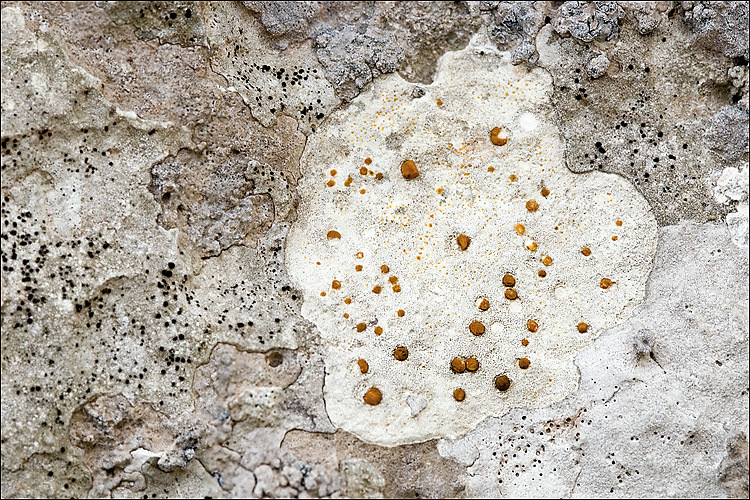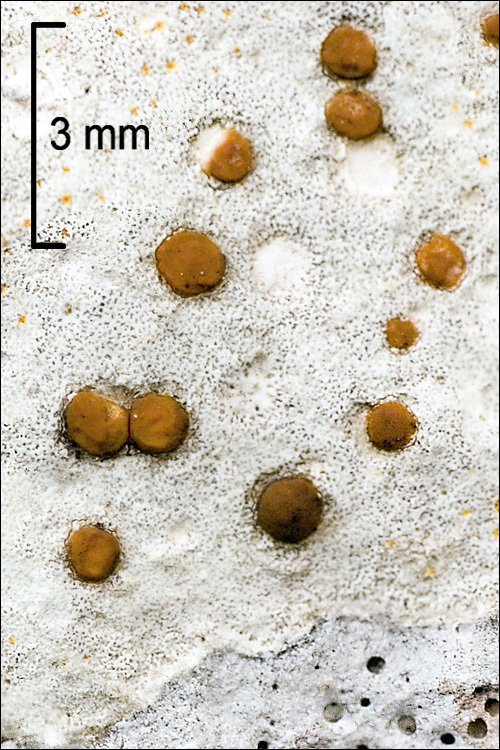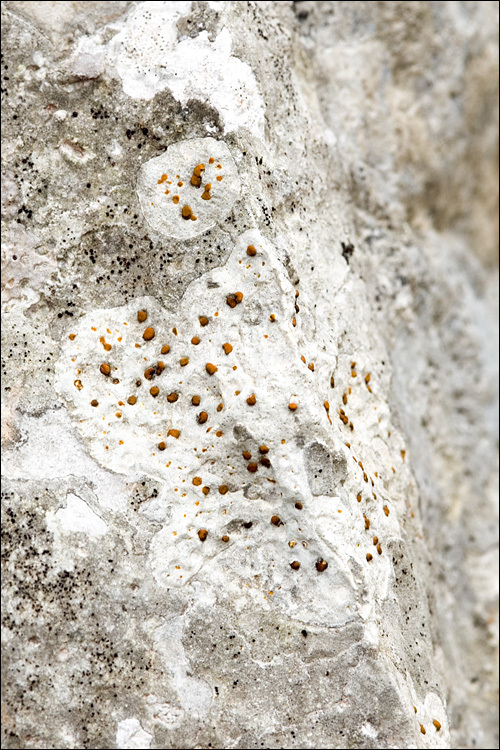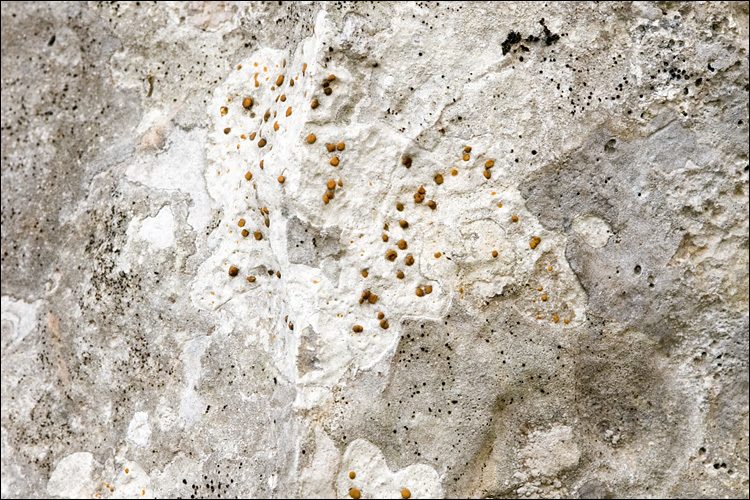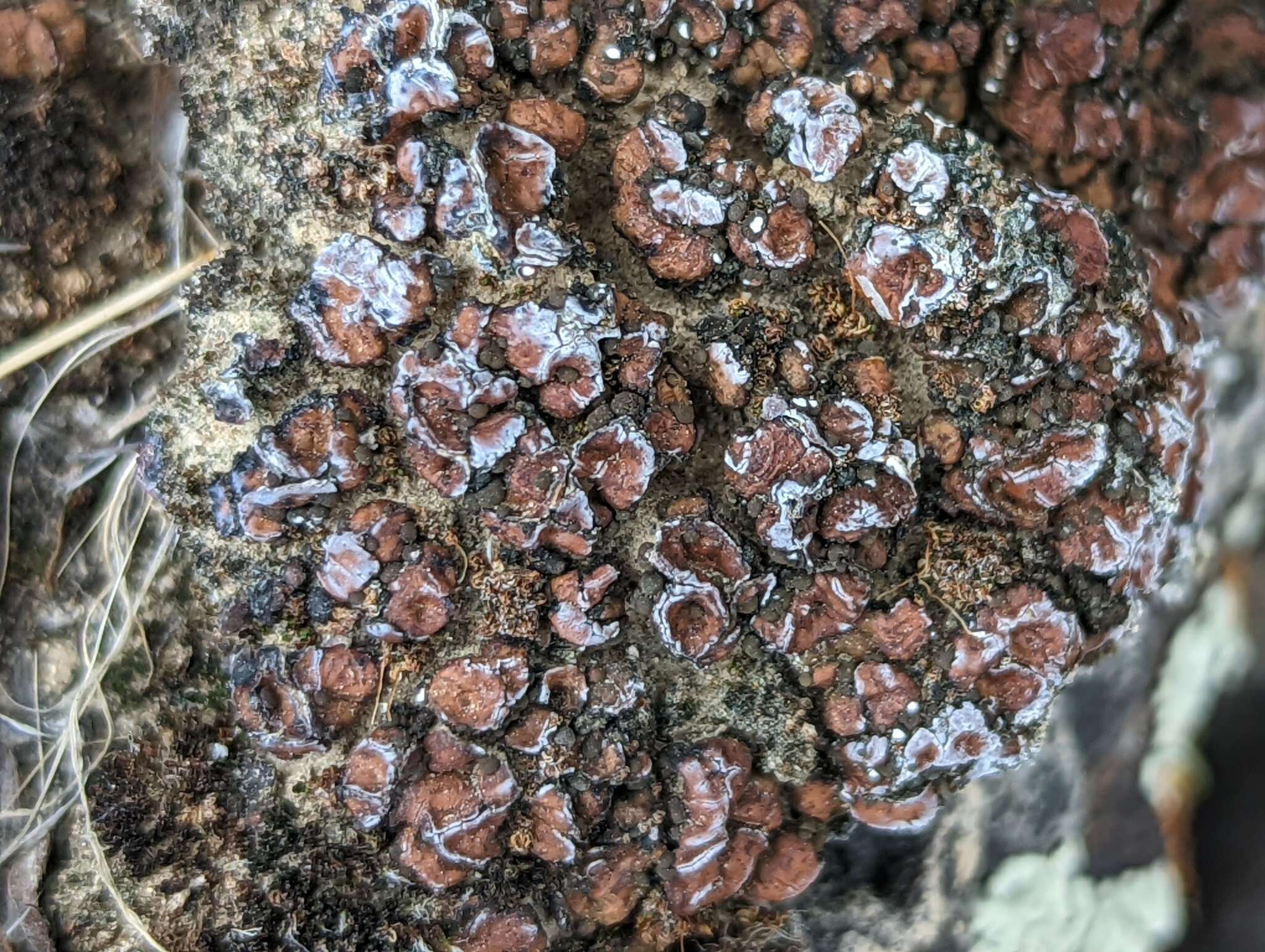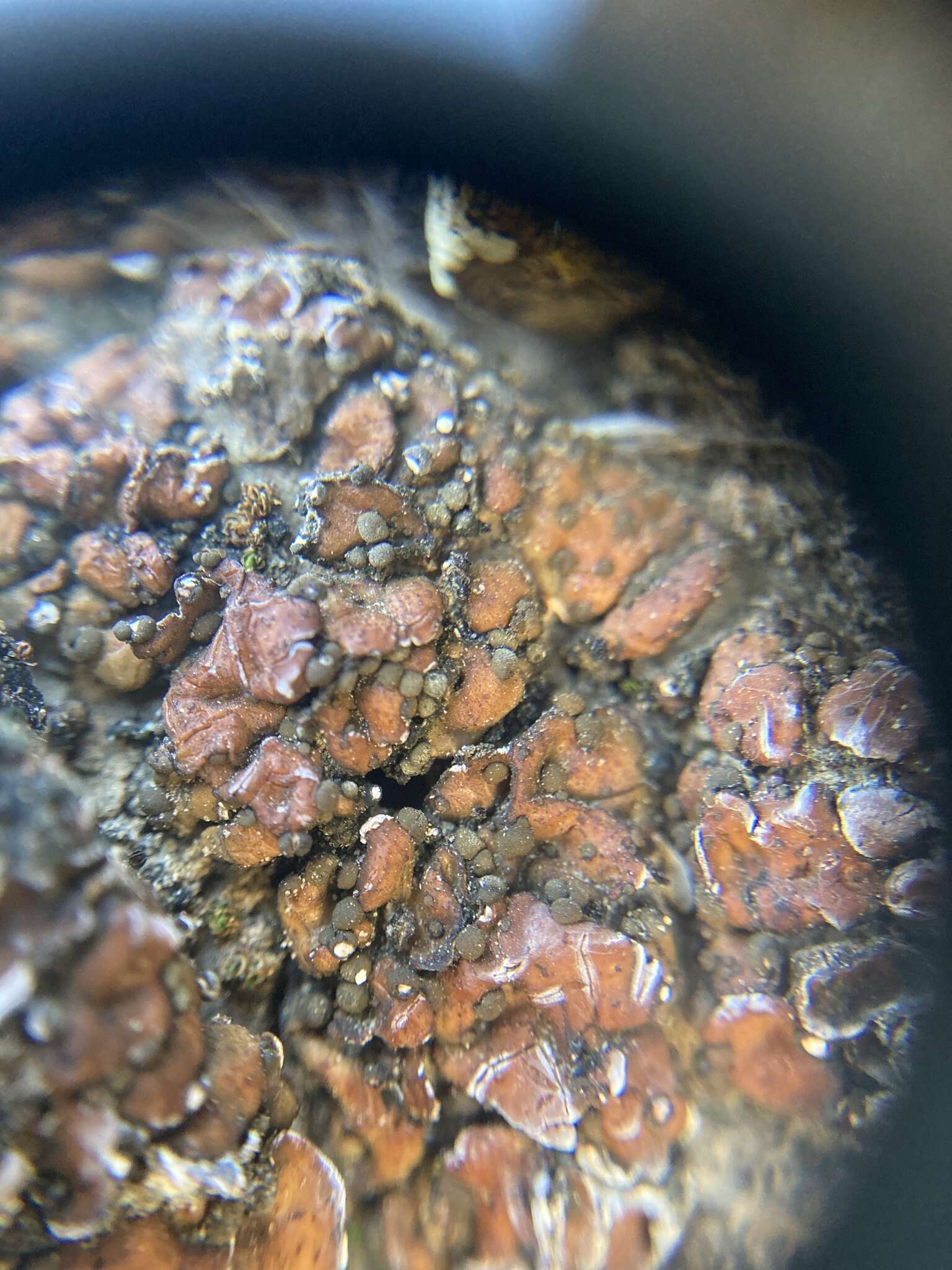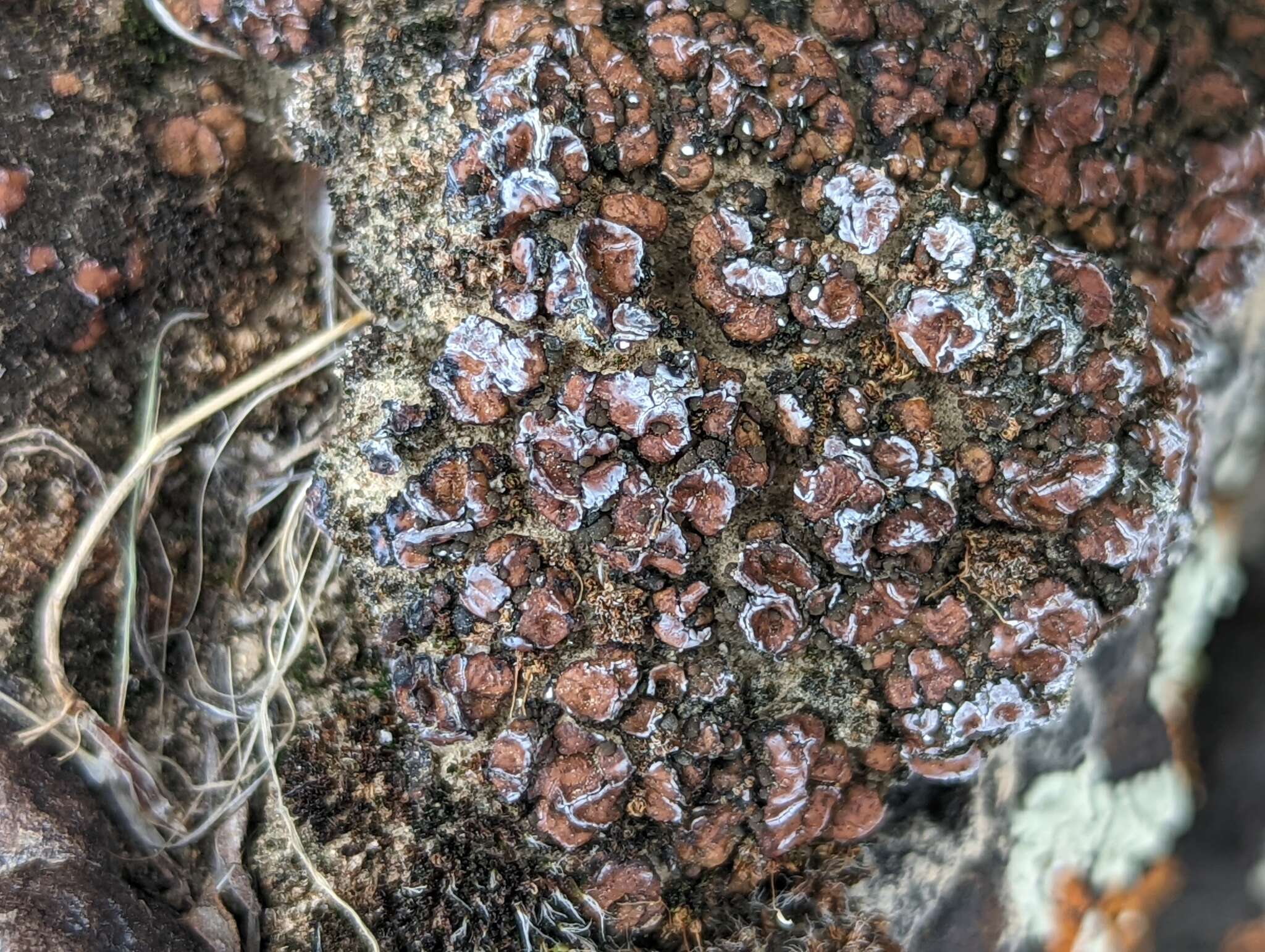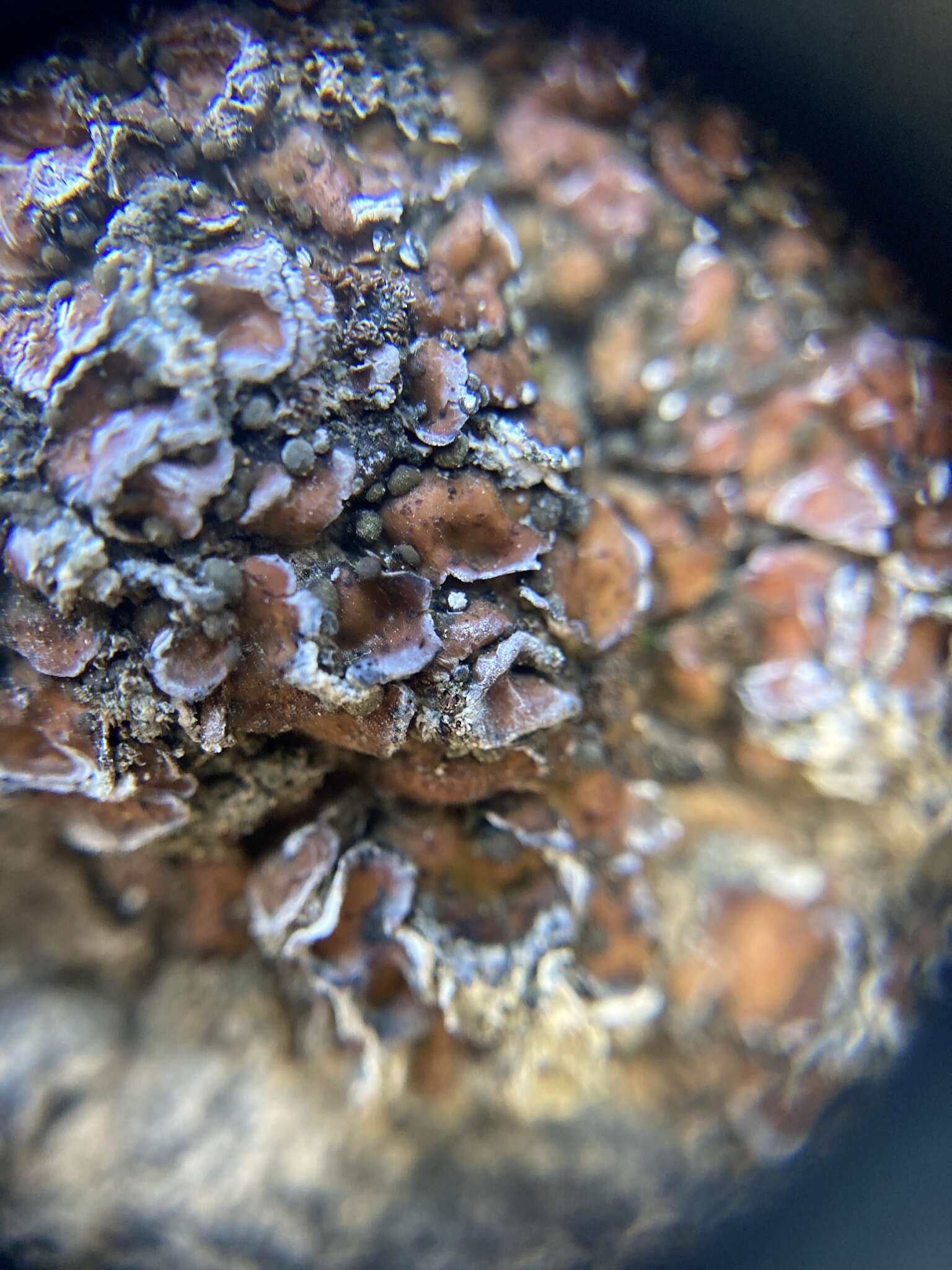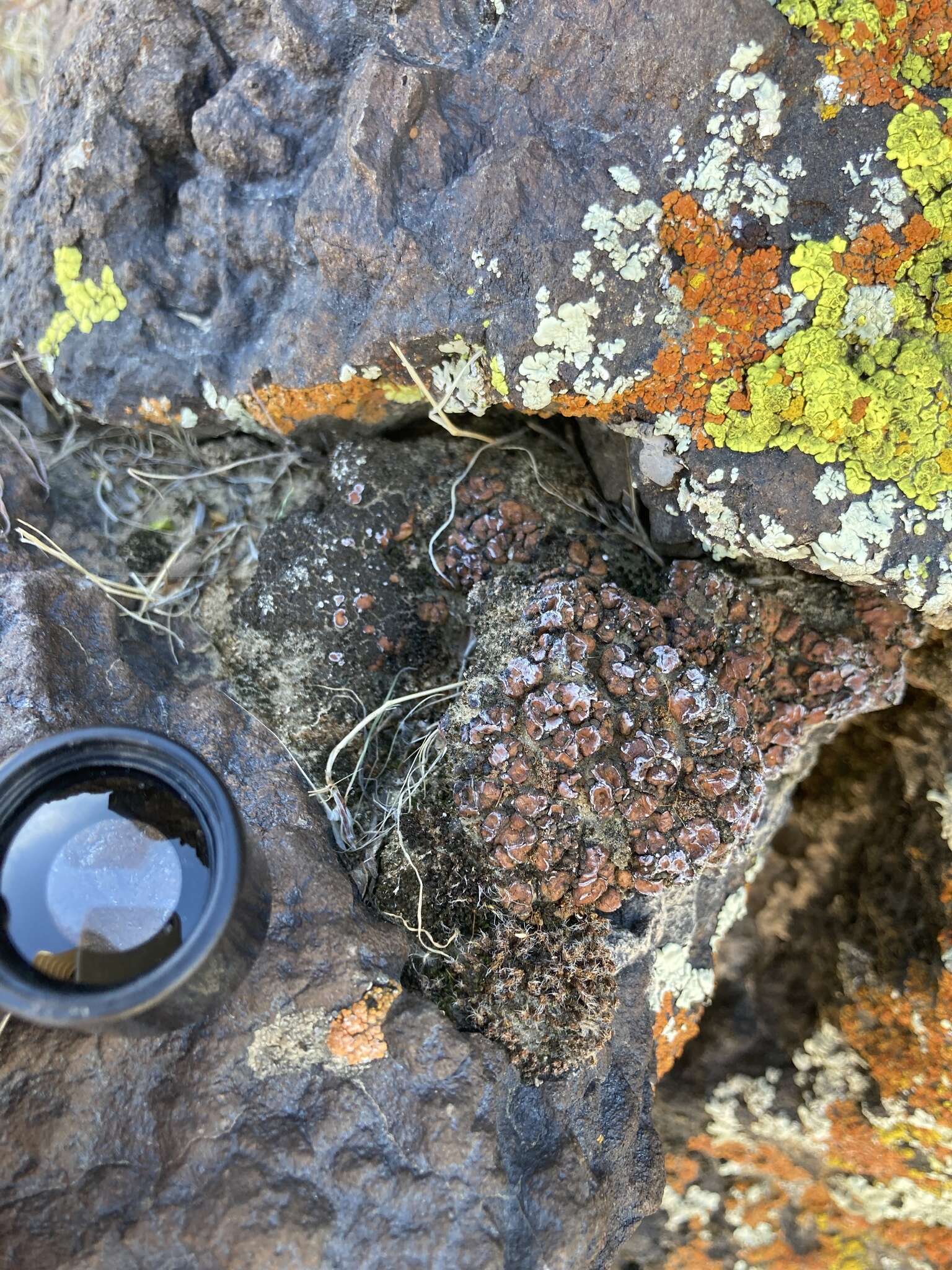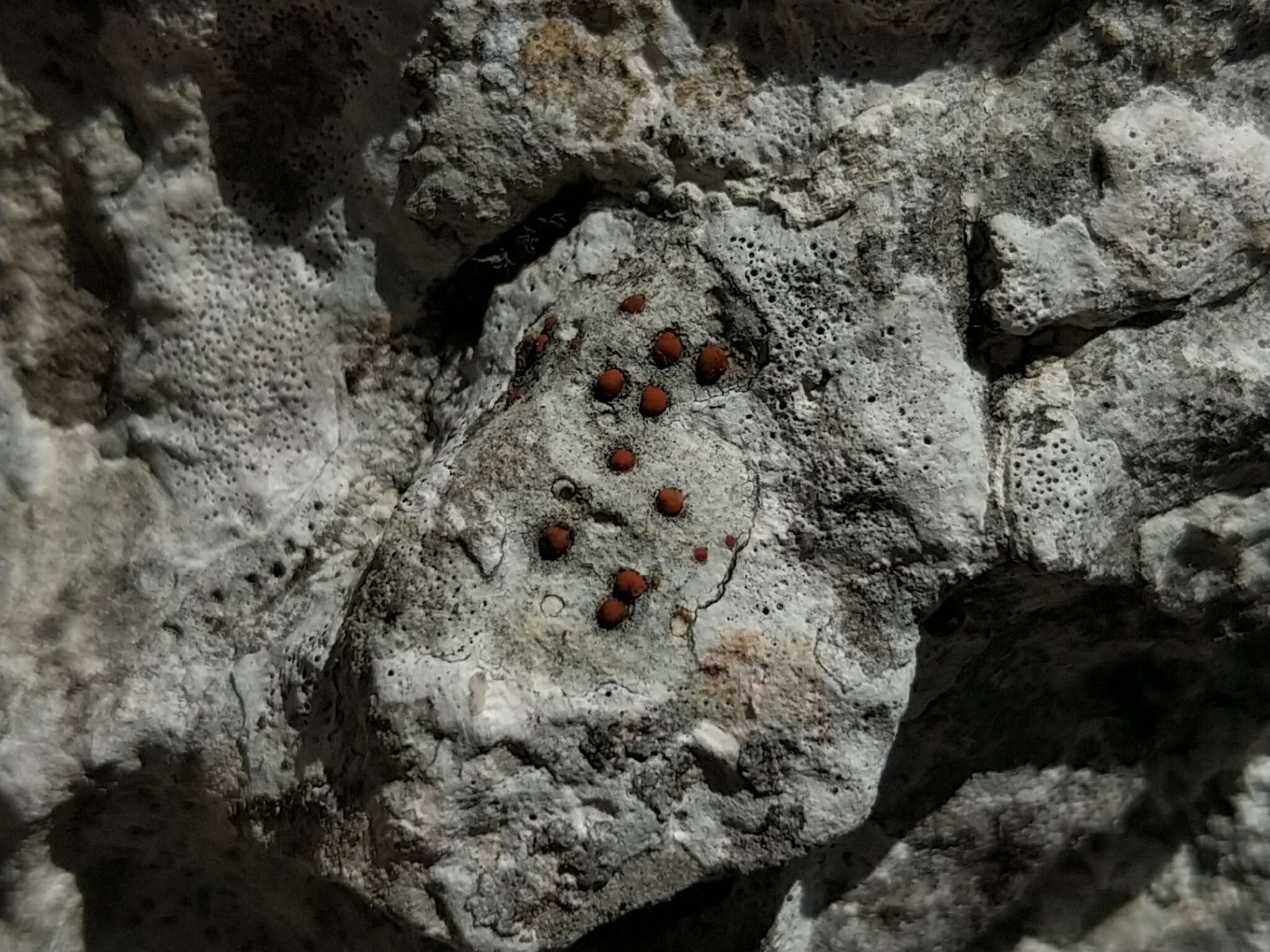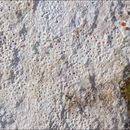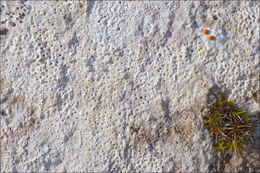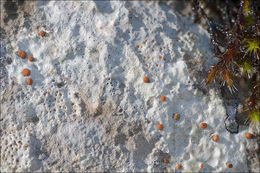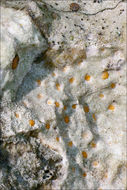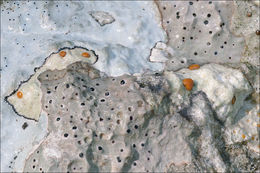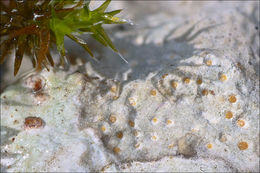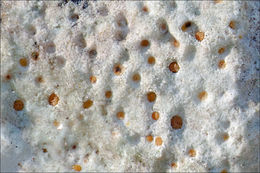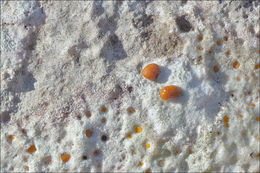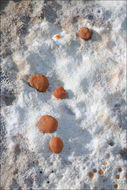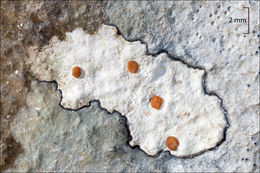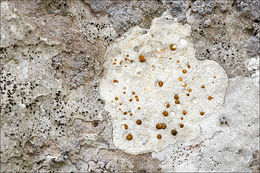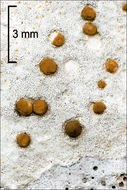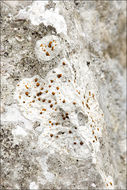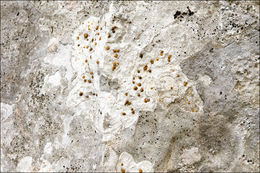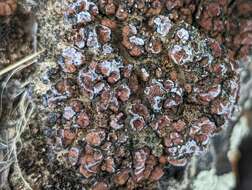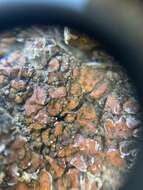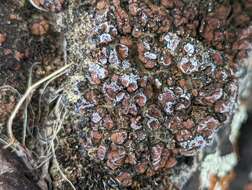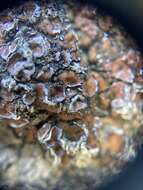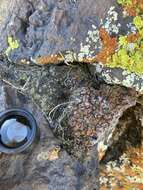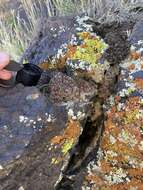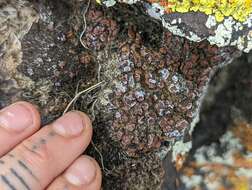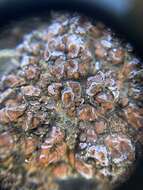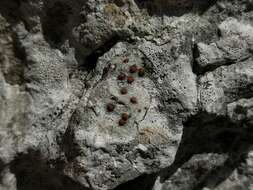-
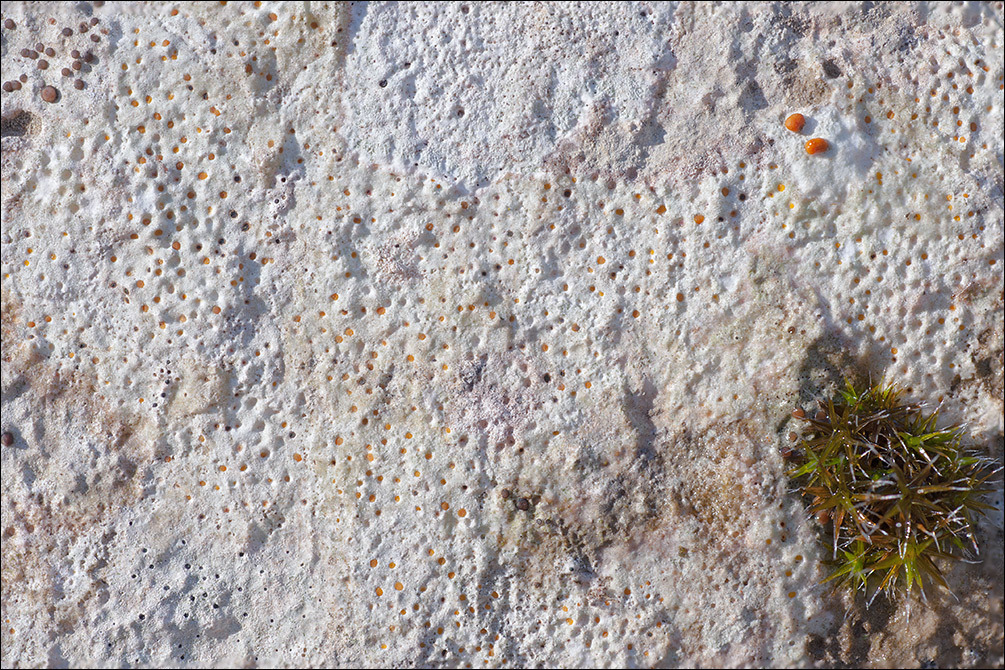
Slo.: ? - syn.: Callopisma rupestre f. incrustans (DC.) Walt. Watson, Caloplaca incrustans (DC.) Flagey, Lecanora incrustans (DC.) Ach., Lecidea incrustans (DC.) Chevall., Lecidea incrustans (DC.) Chevall. - Habitat: man made stone wall delimiting former pastures now partly overgrown with bushes and trees; slightly inclined mountain slope, southeast aspect; calcareous ground; partly in shade; relatively dry and warm place; partly protected from direct rain by tree canopies; average precipitations ~ 3.000 mm/year, average temperature 7-9 deg C, elevations 580 m (1.900 feet), alpine phytogeographical region. - Substratum: +/- vertical hard calcareous rock surface. - Comment: Genus Protoblastenia is comprised by lichens living on rock (saxicolous). Their thallus is crustose or grows within solid rock (endolithic) or it is something in between these two options. These lichens have usually yellow, orange or red apothecia and simple cell spores (Ref.:3). Their similarity to Caloplaca species on macroscopic level causes frequent confusions. However, Caloplaca species have two celled spores (septate spores), which distinguish them from Protoblastenia species with certainty. - Protoblastenia incrustans is a common lichen, but it is certainly many times overlooked. Namely, thallus is usually endolithic and consequently hard to be seen. Its apothecia are very small, from only 200 to 500 microns in diameter (Ref.:3) and can also hardly be seen by naked eye in spite of the fact that they are bright yellow-orange color. Characteristically, its apothecia sit in small pits in the rock. Their surface is from slightly concave to slightly convex shape, most of them are nearly flat. This species is an arctic-alpine element (Ref.:5). - Ref.:(1) F.S. Dobson, Lichens, The Richmonds Publishing Ca.LTD (2005), p 364.(2) http://www.dorsetnature.co.uk/pages-lichen/lch-387.html (accessed 28.2.2018) (3) C.W.Smith, et all, The lichens of Great Britain and Ireland,The British Lichen Society,(2009), p 750.(4) V. Wirth, Die Flechten Baden-Wrttembergs, Teil. 2., Ulmer (1995), p 773.(5) I.M. Brodo, S.D. Sharnoff, S.Sharnoff, Lichens of North America, Yale Uni. Press (2001), p 586.
-
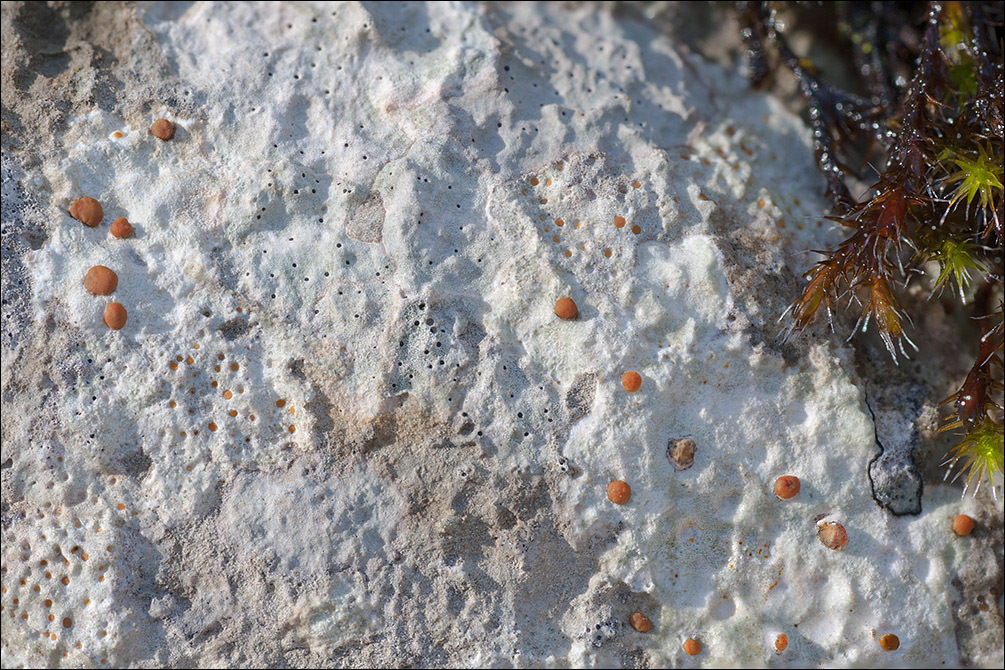
Slo.: ? - syn.: Blastenia rupestris var. calva (Dicks.) Lettau, Lecanora calva (Dicks.) Nyl., Protoblastenia rupestris var. calva (Dicks.) J. Steiner, Lecidea calva (Dicks.) Nyl. - Habitat: man made stone wall delimiting former pastures, which are partly overgrown with bushes and trees now; slightly inclined mountain slope, southeast aspect; calcareous ground; partly in shade; relatively dry and warm place; partly protected from direct rain by tree canopies; average precipitations ~ 3.000 mm/year, average temperature 7-9 deg C, elevations 580 m (1.900 feet), alpine phytogeographical region. Substratum: +/- vertical hard calcareous rock surface. Comment: Protoblastenia calva is not a rare species, however, as almost all endolithic lichens (their thallus is living inside rock among rock grains) is hard to spot from far. This is particularly true if they aren't fertile and dry. They appear as (usually only slightly) 'discolored' rock surface. When wet and fertile they are more apparent since colors are more pronounced. Protoblastenia calva possesses relatively large apothecia (up to 1.5 mm in diameter) of frequently vivid orange color. So, it can be spotted also by naked eye with some attention. Apothecia scattered, sessile, not in pits and from 0,5 to 1,2 mm in diameter, bullate or almost spherical. Thallus endolithic but not completely. Epilithic part white, surface farinous or very finely grainy (Wirth, 1995 - see pic.:10b). Fund on several places of several rocks, almost always right next to Protoblastenia incrustans (small yellow-orange apothecia in pits). Note also slightly darker thallus of Protoblastenia incrustans. Lichens photographed in moist conditions after several rainy days.Ref.:(1) F.S. Dobson, Lichens, The Richmonds Publishing Ca.LTD (2005), p 363.(2) http://dryades.units.it/italic/index.php?procedure=images2&taxon=Protoblastenia%20calva%20(Dicks.)%20Zahlbr%2E (accessed Feb. 25. 2018)(3) http://www.stridvall.se/lichens/gallery/Protoblastenia?page=1 (accessed Feb. 27. 2018) (4) http://www.stridvall.se/lichens/gallery/Protoblastenia/NIKA9793 (accessed Feb. 28. 2018) (5) C.W.Smith, et all, The lichens of Great Britain and Ireland,The British Lichen Society,(2009), p 750.(6) V. Wirth, Die Flechten Baden-Wrttembergs, Teil. 2., Ulmer (1995), p 773.
-
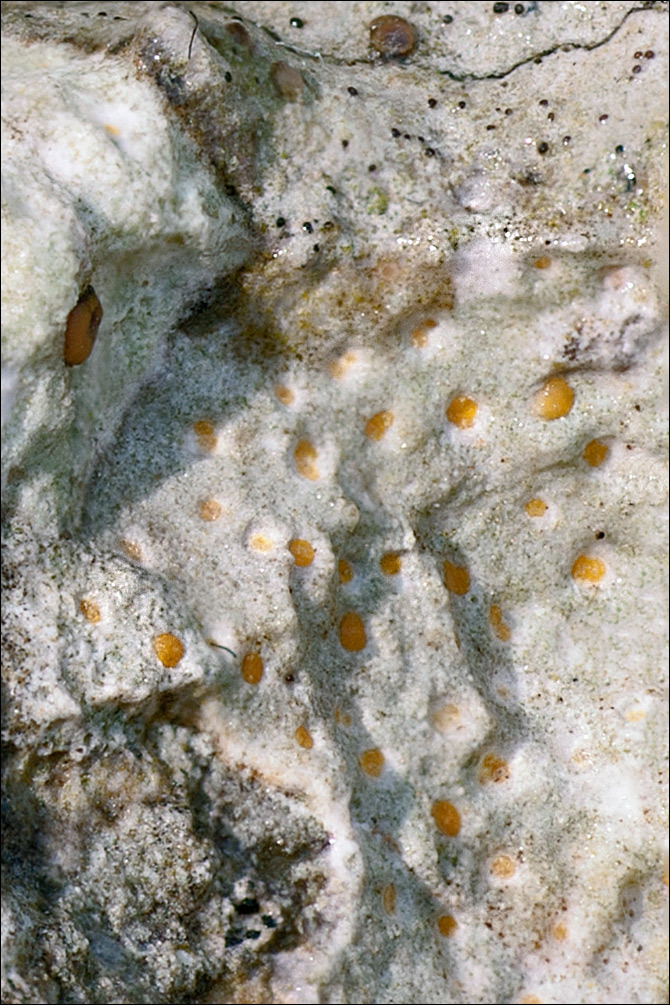
Slo.: ? - syn.: Callopisma rupestre f. incrustans (DC.) Walt. Watson, Caloplaca incrustans (DC.) Flagey, Lecanora incrustans (DC.) Ach., Lecidea incrustans (DC.) Chevall., Lecidea incrustans (DC.) Chevall. - Habitat: man made stone wall delimiting former pastures now partly overgrown with bushes and trees; slightly inclined mountain slope, southeast aspect; calcareous ground; partly in shade; relatively dry and warm place; partly protected from direct rain by tree canopies; average precipitations ~ 3.000 mm/year, average temperature 7-9 deg C, elevations 580 m (1.900 feet), alpine phytogeographical region. - Substratum: +/- vertical hard calcareous rock surface. - Comment: Genus Protoblastenia is comprised by lichens living on rock (saxicolous). Their thallus is crustose or grows within solid rock (endolithic) or it is something in between these two options. These lichens have usually yellow, orange or red apothecia and simple cell spores (Ref.:3). Their similarity to Caloplaca species on macroscopic level causes frequent confusions. However, Caloplaca species have two celled spores (septate spores), which distinguish them from Protoblastenia species with certainty. - Protoblastenia incrustans is a common lichen, but it is certainly many times overlooked. Namely, thallus is usually endolithic and consequently hard to be seen. Its apothecia are very small, from only 200 to 500 microns in diameter (Ref.:3) and can also hardly be seen by naked eye in spite of the fact that they are bright yellow-orange color. Characteristically, its apothecia sit in small pits in the rock. Their surface is from slightly concave to slightly convex shape, most of them are nearly flat. This species is an arctic-alpine element (Ref.:5). - Ref.: (1) F.S. Dobson, Lichens, The Richmonds Publishing Ca.LTD (2005), p 364. (2) http://www.dorsetnature.co.uk/pages-lichen/lch-387.html (accessed 28.2.2018) (3) C.W.Smith, et all, The lichens of Great Britain and Ireland,The British Lichen Society,(2009), p 750. (4) V. Wirth, Die Flechten Baden-Wrttembergs, Teil. 2., Ulmer (1995), p 773. (5) I.M. Brodo, S.D. Sharnoff, S.Sharnoff, Lichens of North America, Yale Uni. Press (2001), p 586.
-
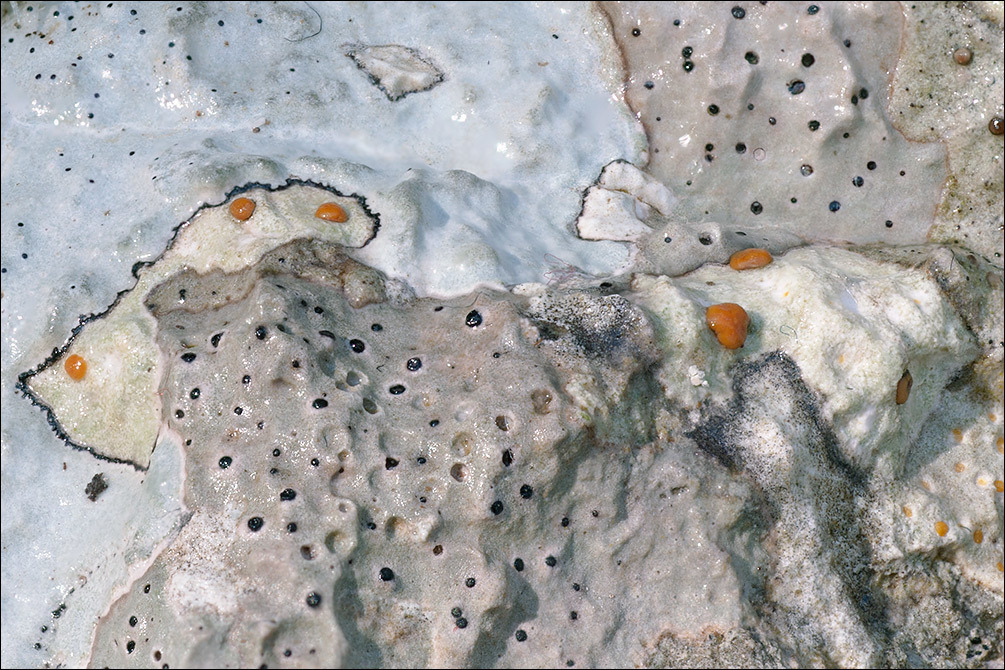
Slo.: ? - syn.: Blastenia rupestris var. calva (Dicks.) Lettau, Lecanora calva (Dicks.) Nyl., Protoblastenia rupestris var. calva (Dicks.) J. Steiner, Lecidea calva (Dicks.) Nyl. - Habitat: man made stone wall delimiting former pastures, which are partly overgrown with bushes and trees now; slightly inclined mountain slope, southeast aspect; calcareous ground; partly in shade; relatively dry and warm place; partly protected from direct rain by tree canopies; average precipitations ~ 3.000 mm/year, average temperature 7-9 deg C, elevations 580 m (1.900 feet), alpine phytogeographical region. Substratum: +/- vertical hard calcareous rock surface. Comment: Protoblastenia calva is not a rare species, however, as almost all endolithic lichens (their thallus is living inside rock among rock grains) is hard to spot from far. This is particularly true if they aren't fertile and dry. They appear as (usually only slightly) 'discolored' rock surface. When wet and fertile they are more apparent since colors are more pronounced. Protoblastenia calva possesses relatively large apothecia (up to 1.5 mm in diameter) of frequently vivid orange color. So, it can be spotted also by naked eye with some attention. Apothecia scattered, sessile, not in pits and from 0,5 to 1,2 mm in diameter, bullate or almost spherical. Thallus endolithic but not completely. Epilithic part white, surface farinous or very finely grainy (Wirth, 1995 - see pic.:10b). Fund on several places of several rocks, almost always right next to Protoblastenia incrustans (small yellow-orange apothecia in pits). Note also slightly darker thallus of Protoblastenia incrustans. Lichens photographed in moist conditions after several rainy days. Ref.: (1) F.S. Dobson, Lichens, The Richmonds Publishing Ca.LTD (2005), p 363. (2) http://dryades.units.it/italic/index.php?procedure=images2&taxon=Protoblastenia%20calva%20(Dicks.)%20Zahlbr%2E (accessed Feb. 25. 2018) (3) http://www.stridvall.se/lichens/gallery/Protoblastenia?page=1 (accessed Feb. 27. 2018) (4) http://www.stridvall.se/lichens/gallery/Protoblastenia/NIKA9793 (accessed Feb. 28. 2018) (5) C.W.Smith, et all, The lichens of Great Britain and Ireland,The British Lichen Society,(2009), p 750. (6) V. Wirth, Die Flechten Baden-Wrttembergs, Teil. 2., Ulmer (1995), p 773.
-

Slo.: ? - syn.: Callopisma rupestre f. incrustans (DC.) Walt. Watson, Caloplaca incrustans (DC.) Flagey, Lecanora incrustans (DC.) Ach., Lecidea incrustans (DC.) Chevall., Lecidea incrustans (DC.) Chevall. - Habitat: man made stone wall delimiting former pastures now partly overgrown with bushes and trees; slightly inclined mountain slope, southeast aspect; calcareous ground; partly in shade; relatively dry and warm place; partly protected from direct rain by tree canopies; average precipitations ~ 3.000 mm/year, average temperature 7-9 deg C, elevations 580 m (1.900 feet), alpine phytogeographical region. - Substratum: +/- vertical hard calcareous rock surface. - Comment: Genus Protoblastenia is comprised by lichens living on rock (saxicolous). Their thallus is crustose or grows within solid rock (endolithic) or it is something in between these two options. These lichens have usually yellow, orange or red apothecia and simple cell spores (Ref.:3). Their similarity to Caloplaca species on macroscopic level causes frequent confusions. However, Caloplaca species have two celled spores (septate spores), which distinguish them from Protoblastenia species with certainty. - Protoblastenia incrustans is a common lichen, but it is certainly many times overlooked. Namely, thallus is usually endolithic and consequently hard to be seen. Its apothecia are very small, from only 200 to 500 microns in diameter (Ref.:3) and can also hardly be seen by naked eye in spite of the fact that they are bright yellow-orange color. Characteristically, its apothecia sit in small pits in the rock. Their surface is from slightly concave to slightly convex shape, most of them are nearly flat. This species is an arctic-alpine element (Ref.:5). - Ref.: (1) F.S. Dobson, Lichens, The Richmonds Publishing Ca.LTD (2005), p 364. (2) http://www.dorsetnature.co.uk/pages-lichen/lch-387.html (accessed 28.2.2018) (3) C.W.Smith, et all, The lichens of Great Britain and Ireland,The British Lichen Society,(2009), p 750. (4) V. Wirth, Die Flechten Baden-Wrttembergs, Teil. 2., Ulmer (1995), p 773. (5) I.M. Brodo, S.D. Sharnoff, S.Sharnoff, Lichens of North America, Yale Uni. Press (2001), p 586.
-
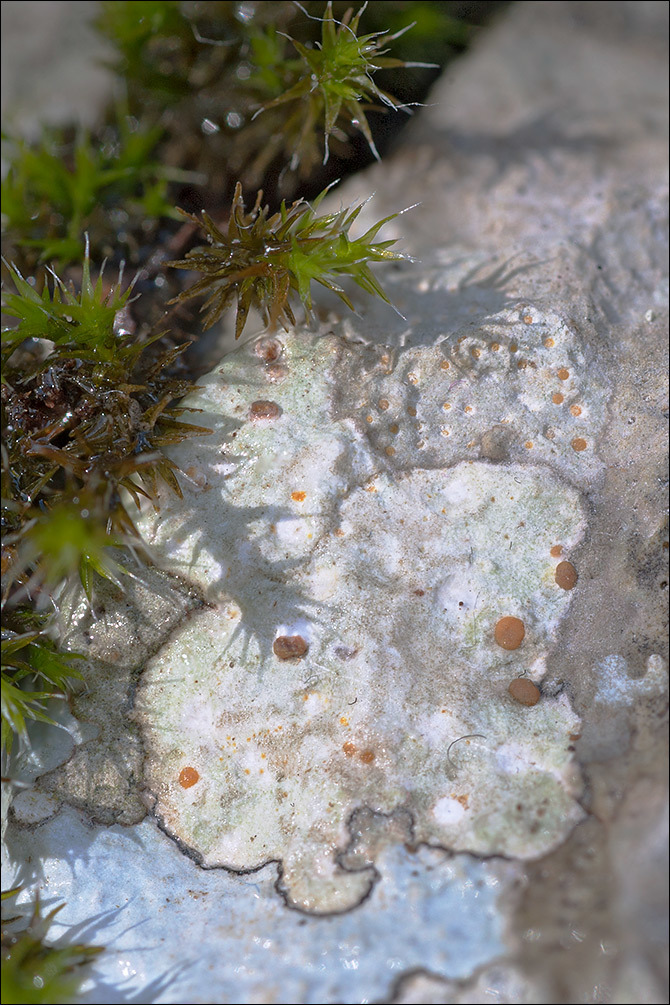
Slo.: ? - syn.: Blastenia rupestris var. calva (Dicks.) Lettau, Lecanora calva (Dicks.) Nyl., Protoblastenia rupestris var. calva (Dicks.) J. Steiner, Lecidea calva (Dicks.) Nyl. - Habitat: man made stone wall delimiting former pastures, which are partly overgrown with bushes and trees now; slightly inclined mountain slope, southeast aspect; calcareous ground; partly in shade; relatively dry and warm place; partly protected from direct rain by tree canopies; average precipitations ~ 3.000 mm/year, average temperature 7-9 deg C, elevations 580 m (1.900 feet), alpine phytogeographical region. Substratum: +/- vertical hard calcareous rock surface. Comment: Protoblastenia calva is not a rare species, however, as almost all endolithic lichens (their thallus is living inside rock among rock grains) is hard to spot from far. This is particularly true if they aren't fertile and dry. They appear as (usually only slightly) 'discolored' rock surface. When wet and fertile they are more apparent since colors are more pronounced. Protoblastenia calva possesses relatively large apothecia (up to 1.5 mm in diameter) of frequently vivid orange color. So, it can be spotted also by naked eye with some attention. Apothecia scattered, sessile, not in pits and from 0,5 to 1,2 mm in diameter, bullate or almost spherical. Thallus endolithic but not completely. Epilithic part white, surface farinous or very finely grainy (Wirth, 1995 - see pic.:10b). Fund on several places of several rocks, almost always right next to Protoblastenia incrustans (small yellow-orange apothecia in pits). Note also slightly darker thallus of Protoblastenia incrustans. Lichens photographed in moist conditions after several rainy days. Ref.: (1) F.S. Dobson, Lichens, The Richmonds Publishing Ca.LTD (2005), p 363. (2) http://dryades.units.it/italic/index.php?procedure=images2&taxon=Protoblastenia%20calva%20(Dicks.)%20Zahlbr%2E (accessed Feb. 25. 2018) (3) http://www.stridvall.se/lichens/gallery/Protoblastenia?page=1 (accessed Feb. 27. 2018) (4) http://www.stridvall.se/lichens/gallery/Protoblastenia/NIKA9793 (accessed Feb. 28. 2018) (5) C.W.Smith, et all, The lichens of Great Britain and Ireland,The British Lichen Society,(2009), p 750. (6) V. Wirth, Die Flechten Baden-Wrttembergs, Teil. 2., Ulmer (1995), p 773.
-
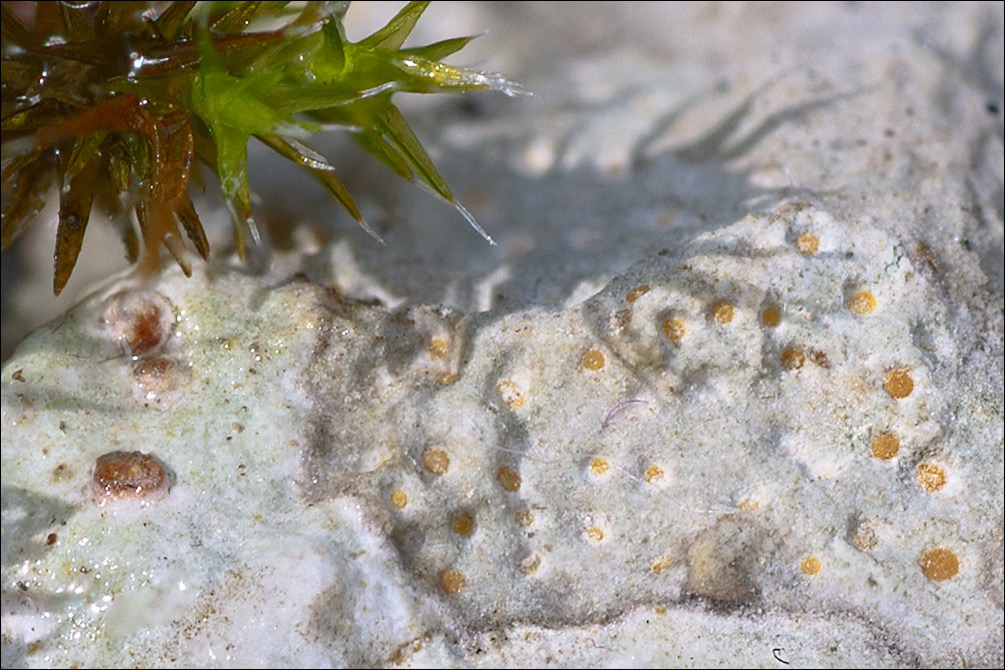
Slo.: ? - syn.: Callopisma rupestre f. incrustans (DC.) Walt. Watson, Caloplaca incrustans (DC.) Flagey, Lecanora incrustans (DC.) Ach., Lecidea incrustans (DC.) Chevall., Lecidea incrustans (DC.) Chevall. - Habitat: man made stone wall delimiting former pastures now partly overgrown with bushes and trees; slightly inclined mountain slope, southeast aspect; calcareous ground; partly in shade; relatively dry and warm place; partly protected from direct rain by tree canopies; average precipitations ~ 3.000 mm/year, average temperature 7-9 deg C, elevations 580 m (1.900 feet), alpine phytogeographical region. - Substratum: +/- vertical hard calcareous rock surface. - Comment: Genus Protoblastenia is comprised by lichens living on rock (saxicolous). Their thallus is crustose or grows within solid rock (endolithic) or it is something in between these two options. These lichens have usually yellow, orange or red apothecia and simple cell spores (Ref.:3). Their similarity to Caloplaca species on macroscopic level causes frequent confusions. However, Caloplaca species have two celled spores (septate spores), which distinguish them from Protoblastenia species with certainty. - Protoblastenia incrustans is a common lichen, but it is certainly many times overlooked. Namely, thallus is usually endolithic and consequently hard to be seen. Its apothecia are very small, from only 200 to 500 microns in diameter (Ref.:3) and can also hardly be seen by naked eye in spite of the fact that they are bright yellow-orange color. Characteristically, its apothecia sit in small pits in the rock. Their surface is from slightly concave to slightly convex shape, most of them are nearly flat. This species is an arctic-alpine element (Ref.:5). - Ref.: (1) F.S. Dobson, Lichens, The Richmonds Publishing Ca.LTD (2005), p 364. (2) http://www.dorsetnature.co.uk/pages-lichen/lch-387.html (accessed 28.2.2018) (3) C.W.Smith, et all, The lichens of Great Britain and Ireland,The British Lichen Society,(2009), p 750. (4) V. Wirth, Die Flechten Baden-Wrttembergs, Teil. 2., Ulmer (1995), p 773. (5) I.M. Brodo, S.D. Sharnoff, S.Sharnoff, Lichens of North America, Yale Uni. Press (2001), p 586.
-

Slo.: ? - syn.: Callopisma rupestre f. incrustans (DC.) Walt. Watson, Caloplaca incrustans (DC.) Flagey, Lecanora incrustans (DC.) Ach., Lecidea incrustans (DC.) Chevall., Lecidea incrustans (DC.) Chevall. - Habitat: man made stone wall delimiting former pastures now partly overgrown with bushes and trees; slightly inclined mountain slope, southeast aspect; calcareous ground; partly in shade; relatively dry and warm place; partly protected from direct rain by tree canopies; average precipitations ~ 3.000 mm/year, average temperature 7-9 deg C, elevations 580 m (1.900 feet), alpine phytogeographical region. - Substratum: +/- vertical hard calcareous rock surface. - Comment: Genus Protoblastenia is comprised by lichens living on rock (saxicolous). Their thallus is crustose or grows within solid rock (endolithic) or it is something in between these two options. These lichens have usually yellow, orange or red apothecia and simple cell spores (Ref.:3). Their similarity to Caloplaca species on macroscopic level causes frequent confusions. However, Caloplaca species have two celled spores (septate spores), which distinguish them from Protoblastenia species with certainty. - Protoblastenia incrustans is a common lichen, but it is certainly many times overlooked. Namely, thallus is usually endolithic and consequently hard to be seen. Its apothecia are very small, from only 200 to 500 microns in diameter (Ref.:3) and can also hardly be seen by naked eye in spite of the fact that they are bright yellow-orange color. Characteristically, its apothecia sit in small pits in the rock. Their surface is from slightly concave to slightly convex shape, most of them are nearly flat. This species is an arctic-alpine element (Ref.:5). - Ref.: (1) F.S. Dobson, Lichens, The Richmonds Publishing Ca.LTD (2005), p 364. (2) http://www.dorsetnature.co.uk/pages-lichen/lch-387.html (accessed 28.2.2018) (3) C.W.Smith, et all, The lichens of Great Britain and Ireland,The British Lichen Society,(2009), p 750. (4) V. Wirth, Die Flechten Baden-Wrttembergs, Teil. 2., Ulmer (1995), p 773. (5) I.M. Brodo, S.D. Sharnoff, S.Sharnoff, Lichens of North America, Yale Uni. Press (2001), p 586.
-

Slo.: ? - syn.: Blastenia rupestris var. calva (Dicks.) Lettau, Lecanora calva (Dicks.) Nyl., Protoblastenia rupestris var. calva (Dicks.) J. Steiner, Lecidea calva (Dicks.) Nyl. - Habitat: man made stone wall delimiting former pastures, which are partly overgrown with bushes and trees now; slightly inclined mountain slope, southeast aspect; calcareous ground; partly in shade; relatively dry and warm place; partly protected from direct rain by tree canopies; average precipitations ~ 3.000 mm/year, average temperature 7-9 deg C, elevations 580 m (1.900 feet), alpine phytogeographical region. Substratum: +/- vertical hard calcareous rock surface. Comment: Protoblastenia calva is not a rare species, however, as almost all endolithic lichens (their thallus is living inside rock among rock grains) is hard to spot from far. This is particularly true if they aren't fertile and dry. They appear as (usually only slightly) 'discolored' rock surface. When wet and fertile they are more apparent since colors are more pronounced. Protoblastenia calva possesses relatively large apothecia (up to 1.5 mm in diameter) of frequently vivid orange color. So, it can be spotted also by naked eye with some attention. Apothecia scattered, sessile, not in pits and from 0,5 to 1,2 mm in diameter, bullate or almost spherical. Thallus endolithic but not completely. Epilithic part white, surface farinous or very finely grainy (Wirth, 1995 - see pic.:10b). Fund on several places of several rocks, almost always right next to Protoblastenia incrustans (small yellow-orange apothecia in pits). Note also slightly darker thallus of Protoblastenia incrustans. Lichens photographed in moist conditions after several rainy days. Ref.: (1) F.S. Dobson, Lichens, The Richmonds Publishing Ca.LTD (2005), p 363. (2) http://dryades.units.it/italic/index.php?procedure=images2&taxon=Protoblastenia%20calva%20(Dicks.)%20Zahlbr%2E (accessed Feb. 25. 2018) (3) http://www.stridvall.se/lichens/gallery/Protoblastenia?page=1 (accessed Feb. 27. 2018) (4) http://www.stridvall.se/lichens/gallery/Protoblastenia/NIKA9793 (accessed Feb. 28. 2018) (5) C.W.Smith, et all, The lichens of Great Britain and Ireland,The British Lichen Society,(2009), p 750. (6) V. Wirth, Die Flechten Baden-Wrttembergs, Teil. 2., Ulmer (1995), p 773.
-

Slo.: ? - syn.: Blastenia rupestris var. calva (Dicks.) Lettau, Lecanora calva (Dicks.) Nyl., Protoblastenia rupestris var. calva (Dicks.) J. Steiner, Lecidea calva (Dicks.) Nyl. - Habitat: man made stone wall delimiting former pastures, which are partly overgrown with bushes and trees now; slightly inclined mountain slope, southeast aspect; calcareous ground; partly in shade; relatively dry and warm place; partly protected from direct rain by tree canopies; average precipitations ~ 3.000 mm/year, average temperature 7-9 deg C, elevations 580 m (1.900 feet), alpine phytogeographical region. Substratum: +/- vertical hard calcareous rock surface. Comment: Protoblastenia calva is not a rare species, however, as almost all endolithic lichens (their thallus is living inside rock among rock grains) is hard to spot from far. This is particularly true if they aren't fertile and dry. They appear as (usually only slightly) 'discolored' rock surface. When wet and fertile they are more apparent since colors are more pronounced. Protoblastenia calva possesses relatively large apothecia (up to 1.5 mm in diameter) of frequently vivid orange color. So, it can be spotted also by naked eye with some attention. Apothecia scattered, sessile, not in pits and from 0,5 to 1,2 mm in diameter, bullate or almost spherical. Thallus endolithic but not completely. Epilithic part white, surface farinous or very finely grainy (Wirth, 1995 - see pic.:10b). Fund on several places of several rocks, almost always right next to Protoblastenia incrustans (small yellow-orange apothecia in pits). Note also slightly darker thallus of Protoblastenia incrustans. Lichens photographed in moist conditions after several rainy days. Ref.: (1) F.S. Dobson, Lichens, The Richmonds Publishing Ca.LTD (2005), p 363. (2) http://dryades.units.it/italic/index.php?procedure=images2&taxon=Protoblastenia%20calva%20(Dicks.)%20Zahlbr%2E (accessed Feb. 25. 2018) (3) http://www.stridvall.se/lichens/gallery/Protoblastenia?page=1 (accessed Feb. 27. 2018) (4) http://www.stridvall.se/lichens/gallery/Protoblastenia/NIKA9793 (accessed Feb. 28. 2018) (5) C.W.Smith, et all, The lichens of Great Britain and Ireland,The British Lichen Society,(2009), p 750. (6) V. Wirth, Die Flechten Baden-Wrttembergs, Teil. 2., Ulmer (1995), p 773.
-
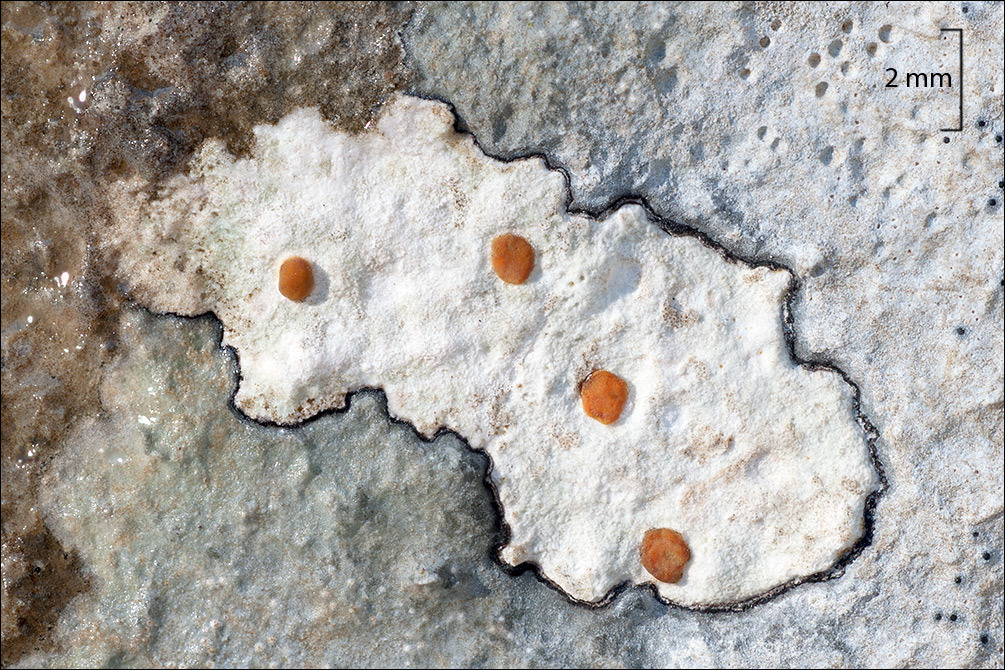
Slo.: ? - syn.: Blastenia rupestris var. calva (Dicks.) Lettau, Lecanora calva (Dicks.) Nyl., Protoblastenia rupestris var. calva (Dicks.) J. Steiner, Lecidea calva (Dicks.) Nyl. - Habitat: man made stone wall delimiting former pastures, which are partly overgrown with bushes and trees now; slightly inclined mountain slope, southeast aspect; calcareous ground; partly in shade; relatively dry and warm place; partly protected from direct rain by tree canopies; average precipitations ~ 3.000 mm/year, average temperature 7-9 deg C, elevations 580 m (1.900 feet), alpine phytogeographical region. Substratum: +/- vertical hard calcareous rock surface. Comment: Protoblastenia calva is not a rare species, however, as almost all endolithic lichens (their thallus is living inside rock among rock grains) is hard to spot from far. This is particularly true if they aren't fertile and dry. They appear as (usually only slightly) 'discolored' rock surface. When wet and fertile they are more apparent since colors are more pronounced. Protoblastenia calva possesses relatively large apothecia (up to 1.5 mm in diameter) of frequently vivid orange color. So, it can be spotted also by naked eye with some attention. Apothecia scattered, sessile, not in pits and from 0,5 to 1,2 mm in diameter, bullate or almost spherical. Thallus endolithic but not completely. Epilithic part white, surface farinous or very finely grainy (Wirth, 1995 - see pic.:10b). Fund on several places of several rocks, almost always right next to Protoblastenia incrustans (small yellow-orange apothecia in pits). Note also slightly darker thallus of Protoblastenia incrustans. Lichens photographed in moist conditions after several rainy days. Ref.: (1) F.S. Dobson, Lichens, The Richmonds Publishing Ca.LTD (2005), p 363. (2) http://dryades.units.it/italic/index.php?procedure=images2&taxon=Protoblastenia%20calva%20(Dicks.)%20Zahlbr%2E (accessed Feb. 25. 2018) (3) http://www.stridvall.se/lichens/gallery/Protoblastenia?page=1 (accessed Feb. 27. 2018) (4) http://www.stridvall.se/lichens/gallery/Protoblastenia/NIKA9793 (accessed Feb. 28. 2018) (5) C.W.Smith, et all, The lichens of Great Britain and Ireland,The British Lichen Society,(2009), p 750. (6) V. Wirth, Die Flechten Baden-Wrttembergs, Teil. 2., Ulmer (1995), p 773.
-
Habitat: On a large boulder on the edge of grassland in an alpine valley, vertical face, east oriented, mostly sunny, partly protected from direct rain, precipitations ~3.000 mm/year, average temperature 6-8 deg C, elevation 870 m (2.850 feet), alpine phytogeographical region. Substratum: large hard cancerous boulder Ref.: F. Dobson, Lichens, The Richmond Publ. (2005), p364. V.Wirth, Die Flechen Baden-Wuerttembergs, Ulmer (1995), Vol. 2., p773. Comment: Determination not certain. Field characters fit well to literature, but no microscopic tests have been done.
-
Habitat: On a large boulder on the edge of grassland in an alpine valley, vertical face, east oriented, mostly sunny, partly protected from direct rain, precipitations ~3.000 mm/year, average temperature 6-8 deg C, elevation 870 m (2.850 feet), alpine phytogeographical region. Substratum: large hard cancerous boulder Ref.: F. Dobson, Lichens, The Richmond Publ. (2005), p364. V.Wirth, Die Flechen Baden-Wuerttembergs, Ulmer (1995), Vol. 2., p773. Comment: Determination not certain. Field characters fit well to literature, but no microscopic tests have been done.
-
Habitat: On a large boulder on the edge of grassland in an alpine valley, vertical face, east oriented, mostly sunny, partly protected from direct rain, precipitations ~3.000 mm/year, average temperature 6-8 deg C, elevation 870 m (2.850 feet), alpine phytogeographical region. Substratum: large hard cancerous boulder Ref.: F. Dobson, Lichens, The Richmond Publ. (2005), p364. V.Wirth, Die Flechen Baden-Wuerttembergs, Ulmer (1995), Vol. 2., p773. Comment: Determination not certain. Field characters fit well to literature, but no microscopic tests have been done.
-
Habitat: On a large boulder on the edge of grassland in an alpine valley, vertical face, east oriented, mostly sunny, partly protected from direct rain, precipitations ~3.000 mm/year, average temperature 6-8 deg C, elevation 870 m (2.850 feet), alpine phytogeographical region. Substratum: large hard cancerous boulder Ref.: F. Dobson, Lichens, The Richmond Publ. (2005), p364. V.Wirth, Die Flechen Baden-Wuerttembergs, Ulmer (1995), Vol. 2., p773. Comment: Determination not certain. Field characters fit well to literature, but no microscopic tests have been done.
-
-
-
-
-
-
-
-
-












